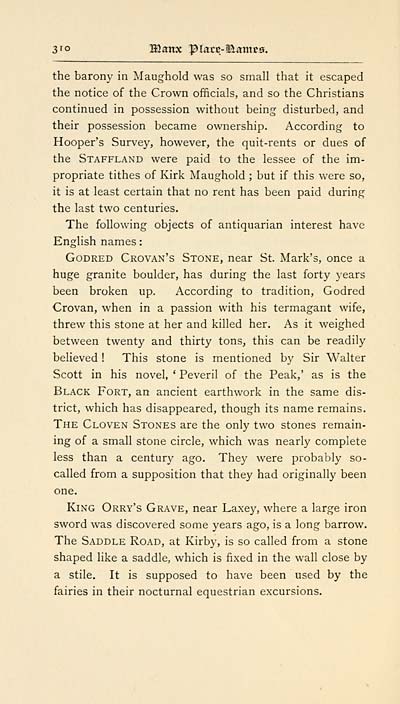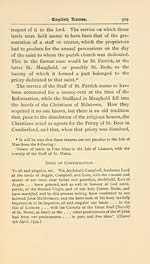Download files
Complete book:
Individual page:
Thumbnail gallery: Grid view | List view

3IO IHanx piate.-ltantBs.
the barony in Maughold was so small that it escaped
the notice of the Crown officials, and so the Christians
continued in possession without being disturbed, and
their possession became ownership. According to
Hooper's Survey, however, the quit-rents or dues of
the Staffland were paid to the lessee of the im-
propriate tithes of Kirk Maughold ; but if this were so,
it is at least certain that no rent has been paid during
the last two centuries.
The following objects of antiquarian interest have
English names :
GoDRED Crovan's Stone, near St. Mark's, once a
huge granite boulder, has during the last forty years
been broken up. According to tradition, Godred
Crovan, when in a passion with his termagant wife,
threw this stone at her and killed her. As it weighed
between twenty and thirty tons, this can be readily
beUeved ! This stone is mentioned by Sir Walter
Scott in his novel, * Peveril of the Peak,' as is the
Black Fort, an ancient earthwork in the same dis-
trict, which has disappeared, though its name remains.
The Cloven Stones are the only two stones remain-
ing of a small stone circle, which was nearly complete
less than a century ago. They were probably so-
called from a supposition that they had originally been
one.
King Orry's Grave, near Laxey, where a large iron
sword was discovered some years ago, is a long barrow.
The Saddle Road, at Kirby, is so called from a stone
shaped like a saddle, which is fixed in the wall close by
a stile. It is supposed to have been used by the
fairies in their nocturnal equestrian excursions.
the barony in Maughold was so small that it escaped
the notice of the Crown officials, and so the Christians
continued in possession without being disturbed, and
their possession became ownership. According to
Hooper's Survey, however, the quit-rents or dues of
the Staffland were paid to the lessee of the im-
propriate tithes of Kirk Maughold ; but if this were so,
it is at least certain that no rent has been paid during
the last two centuries.
The following objects of antiquarian interest have
English names :
GoDRED Crovan's Stone, near St. Mark's, once a
huge granite boulder, has during the last forty years
been broken up. According to tradition, Godred
Crovan, when in a passion with his termagant wife,
threw this stone at her and killed her. As it weighed
between twenty and thirty tons, this can be readily
beUeved ! This stone is mentioned by Sir Walter
Scott in his novel, * Peveril of the Peak,' as is the
Black Fort, an ancient earthwork in the same dis-
trict, which has disappeared, though its name remains.
The Cloven Stones are the only two stones remain-
ing of a small stone circle, which was nearly complete
less than a century ago. They were probably so-
called from a supposition that they had originally been
one.
King Orry's Grave, near Laxey, where a large iron
sword was discovered some years ago, is a long barrow.
The Saddle Road, at Kirby, is so called from a stone
shaped like a saddle, which is fixed in the wall close by
a stile. It is supposed to have been used by the
fairies in their nocturnal equestrian excursions.
Set display mode to: Large image | Transcription
Images and transcriptions on this page, including medium image downloads, may be used under the Creative Commons Attribution 4.0 International Licence unless otherwise stated. ![]()
| Early Gaelic Book Collections > Blair Collection > Surnames & place-names of the Isle of Man > (328) |
|---|
| Permanent URL | https://digital.nls.uk/82103584 |
|---|
| Description | A selection of books from a collection of more than 500 titles, mostly on religious and literary topics. Also includes some material dealing with other Celtic languages and societies. Collection created towards the end of the 19th century by Lady Evelyn Stewart Murray. |
|---|
| Description | Selected items from five 'Special and Named Printed Collections'. Includes books in Gaelic and other Celtic languages, works about the Gaels, their languages, literature, culture and history. |
|---|

